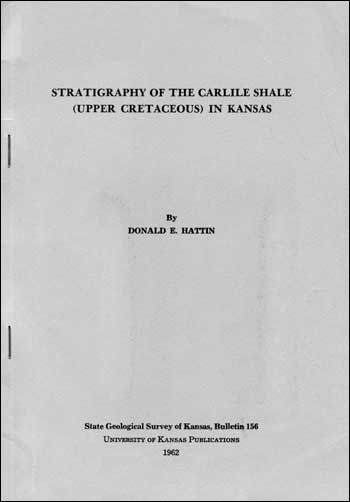Stratigraphy of the Carlile Shale (Upper Cretaceous) in Kansas
By Donald E. Hattin

Originally published in 1962 as Kansas Geological Survey Bulletin 156. This is, in general, the original text as published. An Acrobat PDF version (24 MB) is also available; large plates available separately.
Abstract
The Carlile Shale of Kansas was examined at numerous places, fossils were collected at 56 localities, and 47 sections were measured. Stratigraphic relations are depicted in graphic columns. The known ranges of macrofossils in the Kansas Carlile are tabulated graphically and characteristic species are figured.
From the standpoints of general lithology, chemistry, environment of deposition, mappability, and fauna, the Fairport Chalk Member should be accorded formational status, as should the combined Blue Hill Shale and Codell Sandstone Members.
Fairport marker beds include 13 layers of chalky limestone, marly chalk, and bentonite, and Blue Hill marker beds include 7 layers of clay-ironstone concretions, septarian concretions, and bentonite that provide a framework for more detailed studies.
The Greenhorn Limestone and Fairport Member of the Carlile are entirely conformable, the Fairport-Blue Hill contact is conformable, and the Blue Hill-Codell contact is gradational both vertically and laterally, but absence of the zones of Scaphites nigricollensis and S. corvensis, which characterize highest Carlile strata in the Black Hills region, in combination with stratigraphic and lithologic evidence, is proof that the Niobrara Chalk rests on the Carlile Shale with regional diastem.
Carbonate sediments of the Fairport were generated wholly within the depositional basin and consist of micro- and macrofossils, calcareous ooze, recrystallized calcite, sparry calcite, and fecal pellets of unknown organisms that fed upon coccolithophores. Terrigenous detritus, consisting mostly of clay and very fine silt. is nearly lacking in lower Fairport beds but is more abundant toward the top of the member. Sparseness of detritus, lamination of chalky shales, and paucity of structural features associated with turbulence are evidence that Fairport sediment was deposited under generally quiet conditions, far from shore, in relatively clear to very clear water, and below the depth of normal wave activity. Beds of chalky limestone and marly chalk represent sediment that was reworked by gentle turbulence; calcarenite lenses are the product of short intervals of severe stirring of bottom sediments by waves.
Blue Hill and Codell strata are composed chiefly of fine-grained terrigenous detritus deposited rapidly from turbid waters of a nearer-shore environment than that represented by the Fairport, but mostly deeper than that in which wave and current activity is normal. The upward coarsening of detritus in the Blue Hill-Codell section and local development of cross-laminated and ripple-marked beds near the top of the Carlile indicates the approach to the Kansas area of a regressive shoreline. Abundant septarian concretions and pyrite nodules of the Blue Hill Member are products of early diagenesis.
Slow sedimentation and general lack of turbidity during most of Fairport deposition favored development of an extensive benthonic fauna in well-oxygenated water. Inoceramus cuvieri, which commonly reached a breadth of 3 feet, provided the substratum for an extensive epizoal growth of Ostrea congesta, bryozoans, serpulids, and barnacles. Normal salinity is indicated by the fauna. Increased turbidity during Blue Hill deposition reduced the sessile benthos to a small number of O. congesta; salinity remained normal. The benthonic fauna is evidence of well-oxygenated water; the near absence of fossils at many exposures is the result of nonpreservation rather than inhospitable bottom conditions.
The Fairport Member lies wholly within the range of Collignoniceras woollgari. The Blue Hill Member coincides with the range of Collignoniceras hyatti. Codell strata of Kansas contain few macroinvertebrates, but Prionocyclus wyomingensis is abundant at one locality. The zone of Scaphites warreni, which normally lies between the zones of C. hyatti and P. wyomingensis, cannot be distinguished in Kansas, but strata in that part of the section are entirely conformable. Evidence is summarized for correlation of the Kansas Carlile with strata of the Western Interior and Gulf Coastal Plain and with the zone of Terebratulina lata and at least the lower part of the zone of Holaster planus of the English Middle Chalk on the basis of stratigraphic distribution of C. woollgari, Inoceramus labiatus (broad form), I. latus, and Prionocyclus.
Strata of the Carlile Shale of Kansas represent the regressive half of the first major Late Cretaceous cycle of sedimentation in the Western Interior region. Chief elements of the cycle are (1) siltstone or sandstone, (2) dark-gray silty and sandy clay shale, (3) dark-gray locally concretionary silty clay shale, (4) chalky shale and limestone, (5) dark-gray concretionary silty clay shale, (6) dark-gray silty and sandy shale, and (7) siltstone or sandstone. The first phase of deposition is represented by the Dakota Formation, the second and third by the lower and upper parts of the Graneros Shale, respectively. The fourth phase (maximum transgression) is represented by the Greenhorn and Fairport; regression began during Fairport sedimentation. The fifth and sixth phases are represented by the lower and upper parts of the Blue Hill, respectively, and the last phase by the Codell.
Kansas Geological Survey, Geology
Placed on web March 11, 2010; originally published May 1962.
Comments to webadmin@kgs.ku.edu
The URL for this page is http://www.kgs.ku.edu/Publications/Bulletins/156/index.html